Umeboshi (Pickled Plums): A Traditional Japanese Preserved Food
Dec 20,2012
Umeboshi (Pickled Plums): A Traditional Japanese Preserved Food
Dec 20,2012

Our ability to obtain fruits, vegetables, and seafood regardless of the season is a very recent phenomenon. Before modern refrigeration and transportation technologies, people had no choice but to eat what was available at the time.
People living in temperate regions, where fresh food is available throughout the year, can depend on seasonal produce alone. But in many parts of the world, due to climate or topography, it is hard to secure food for long periods during the year. This necessity drove people to develop preserves. A wide variety of techniques, such as fermenting, drying, or smoking perishable foodstuffs, are used to make preserves. Even today, many kinds of preserves are being formulated and produced all over the world.
This series is a journey that explores the mastery of preserves and the wisdom of everyday living, which form the foundation of food cultures. In this first installment, we will explore pickled plums, known as umeboshi, an indispensable part of the Japanese diet. 
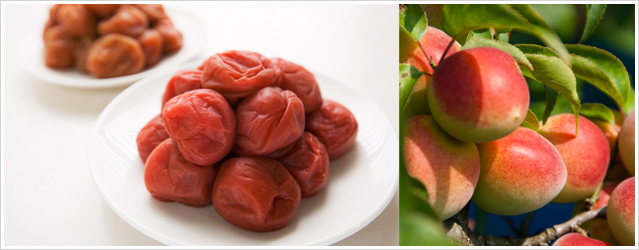
Pickled plums (ume) are made by pickling the ume fruit in salt and then drying them in the sun. If done with the right process, umeboshi can be the ultimate preserve, lasting for years, even decades (and in some cases, even over a century) without going bad.
People in Japan began making umeboshi in the Heian period (794 to 1185). Initially, umeboshi were applied as medicinal products for the upper classes. Legend has it that Emperor Murakami (926 – 967) was cured of an illness with a treatment of umeboshi and kelp tea. When the country entered the Sengoku period (1467 to 1615), umeboshi were essential for the warriors who went into battle. They used umeboshi to disinfect wounds on the battlefield and to prevent food poisoning and infectious diseases.
The majority of the population, however, did not start routinely having umeboshi as a side dish until the Edo period (1603 to 1868), when ume cultivation flourished in the country. Once it became easy to obtain fresh ume, people began to pickle the fruit to their own liking.
While fewer households today make their own umeboshi, they are as common as ever, widely available at supermarkets and convenience stores. According to the Statistics Bureau of Japan, in 2010, people on average purchased around 800 grams of umeboshi per year. Assuming each ume weighs approximately 15 to 30 grams, each person consumes between 30 and 50 umeboshi a year. How many do you eat a year?
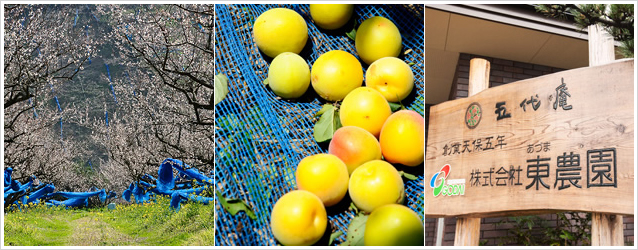
If umeboshi were to have a home, it would be in Wakayama prefecture. Central Wakayama is blessed with a mild climate throughout the year. The Kishu Tokugawa family, one of the three Tokugawa Houses, ruled the area in the Edo period. Ume cultivation was encouraged under the reign of the first feudal lord Yorinobu, the 10th son of Tokugawa Ieyasu, and the area has been a center of ume production ever since. Wakayama continues to be Japan’s leading ume producer, growing over 60 percent (approximately 60,000 tons per year) of the country’s ume crop.
Among the many varieties of ume, nanko-ume, developed in the 1950s, is considered the top brand in the umeboshi world because of its distinctive thin, soft skin and thick, evenly textured fruit pulp. For this article, we visited Azuma Noen, a farm that has been in business for 178 years, located in the nanko-ume heartland. Azuma Noen has a proud lineage of offering umeboshi to deities enshrined at the Osaka Tenmangu shrine and the Kumano Hongu Taisha shrine. Their signature product, Kishu Godaiume, consisting of only ripe Grade A Kishu nanko-ume pickled using their own unique method, is often featured in the media as the gift of choice for celebrities and cultural figures. Let’s delve into the secrets of their highest grade umeboshi, which sells for 400 yen per ume (packaged in a Heart of Kishu Godaiume decorative box).
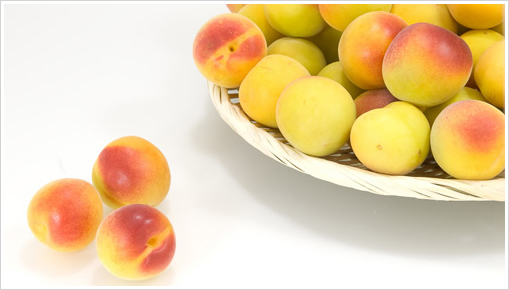
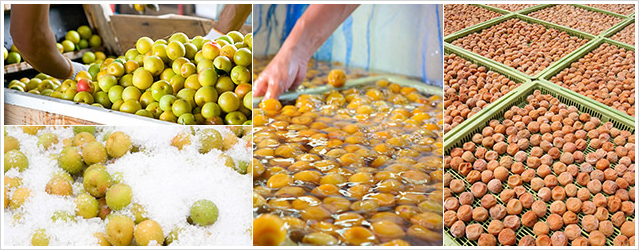
Ume trees blossom in February. White ume blossoms, this time of year, cover the mountainsides as far as the eye can see and their sweet-sour aroma spreads far into the distance, proving the area’s old adage: “The eye fills with a million trees; and the fragrance travels for miles”. Many sightseers visit Minabe, Wakayama, famous for producing nanko-ume, to take in the views. But this is also the pollination season, which is essential to producing umeboshi.
“Ume are not self-fertilizing; so we get the bees to help”, explains Dogaki Toshiaki, director and factory manager of Azuma Noen. Indeed, the year’s harvest can be estimated by how active the bees are. From the outside, the ume groves look beautiful, but descend within and you will find swarms of bees flitting about from tree to tree. After the blossoms scatter, the fruit begins to grow, and in June the ripe fruit falls to the ground.
“Ume trees do not bear fruit right after being planted. A tree only begins to produce its first fruit once it is about six years old. Even then, we only harvest ume for umeboshi from trees that are 15 to 20 years old. Trees older or younger than this do not bear many fruit.” The time an ume tree is fruitful is surprisingly short.
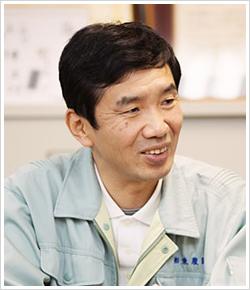
The fruit that fall naturally from the trees are checked for size, ripeness, and marks or blemishes and then pickled in salt on the same day.
“The fruit are pickled in natural sun-dried salt and ume-flavored salt extracted from ume vinegar. Sometimes nigari bitterns are added depending on the size and firmness of the fruit. Our workers use their intuition to make each fine adjustment.” After soaking for around a month and after the rainy season clears, the umeboshi are sun-dried for about a week. Inexpensive imported umeboshi are reportedly dried in special dryers, but Azuma Noen dries all its produce under the sun. They even go to the trouble of turning each umeboshi over as they dry.
“We’ve experimented with dryers, but the color, aroma, and texture of the pulp come out wrong. There are no shortcuts. [laughs]” After these processes, the umeboshi with about 20 percent salt content (called shiraboshi) are ready. In this state, the umeboshi can be stored for ten to twenty years. But what’s really popular with customers recently are seasoned umeboshi that undergo further processing. Read on to find out what these are.
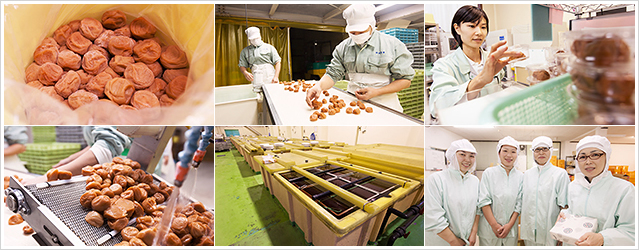
The thin, delicate skin of nanko-ume is often damaged while being handled. Workers carefully check, by hand and eye, the shiraboshi after being rinsed in water. Fruits that fail inspection are sorted and used as ingredients in rice balls and other applications. No ume is wasted.
The best fruit have their excess salt removed before being liberally soaked in a top-secret mixture of seasonings. This is where the skill of an umeboshi maker really shines.
“We soak our umeboshi for about a month, which is more than twice as long as usual. This allows the flavor to penetrate so deeply that you can enjoy the flavor even by sucking the seeds. We also frequently adjust the seasoning mixture, which costs more, but that’s the secret to their delicious taste.”
Once they have thoroughly matured in the seasoning mixture, the nanko-ume undergo quality inspections at the laboratory. They are tested for salt content, sugar content, acidity, and other factors. If they pass, they are neatly wrapped in bags and boxed for shipping nationwide.
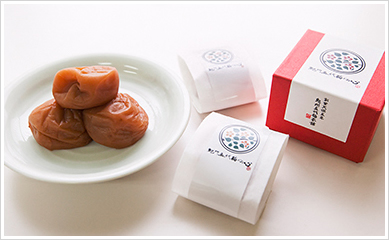
We are given a Heart of Kishu Godaiume box, which is hugely popular as a gift, containing large umeboshi weighing around 30 grams each.
For a moment, we are lost for words. They are completely different from anything we have tasted before. In a word, they are incredibly fruity, more like fruit than an ordinary umeboshi. The soft pulp and juice simply bloom in your mouth. If this isn’t juicy, what is? With about 10 percent salt content, they are somewhat strong for seasoned umeboshi, but you could definitely have several without any rice. The secret of their popularity was now clear to us.
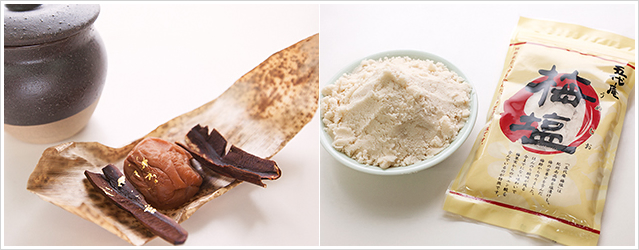
Azuma Noen sells umeboshi steeped in such special seasonings as honey and mirin seasoning as well as an assortment of umeboshi preserved in red shiso, kelp, and brown sugar. But perhaps their most unusual offering is Gofuku [Five Luck] shown in the photo above. (It comes in a pot, housed in a wooden box, for 3,150 yen.) These particular umeboshi are considered to bring good luck because they were pickled in the Year of the Monkey (2004). They rest between shelf fungi — known as saruno koshikake or Monkey’s Bench — and are sprinkled with gold leaf. Because they are shiraboshi, they have a long shelf life. The expiry date is 2064, meaning children born in 2004 can eat them on their 60th birthday.
Ume salt is produced by drying the ume vinegar created while processing umeboshi and goes well with fish dishes and rice balls. There are many other byproducts of umeboshi production, including ume liquor, ume sesame, and umeboshi kelp tea. Umeboshi are simply marvelous.